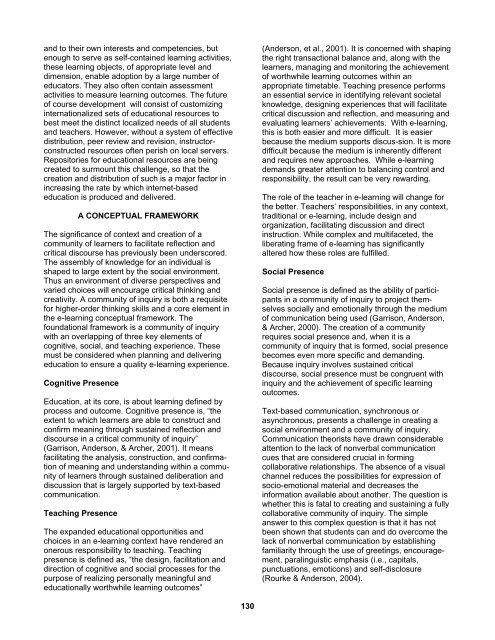2008 - Marketing Educators' Association
2008 - Marketing Educators' Association
2008 - Marketing Educators' Association
You also want an ePaper? Increase the reach of your titles
YUMPU automatically turns print PDFs into web optimized ePapers that Google loves.
and to their own interests and competencies, but<br />
enough to serve as self-contained learning activities,<br />
these learning objects, of appropriate level and<br />
dimension, enable adoption by a large number of<br />
educators. They also often contain assessment<br />
activities to measure learning outcomes. The future<br />
of course development will consist of customizing<br />
internationalized sets of educational resources to<br />
best meet the distinct localized needs of all students<br />
and teachers. However, without a system of effective<br />
distribution, peer review and revision, instructorconstructed<br />
resources often perish on local servers.<br />
Repositories for educational resources are being<br />
created to surmount this challenge, so that the<br />
creation and distribution of such is a major factor in<br />
increasing the rate by which internet-based<br />
education is produced and delivered.<br />
A CONCEPTUAL FRAMEWORK<br />
The significance of context and creation of a<br />
community of learners to facilitate reflection and<br />
critical discourse has previously been underscored.<br />
The assembly of knowledge for an individual is<br />
shaped to large extent by the social environment.<br />
Thus an environment of diverse perspectives and<br />
varied choices will encourage critical thinking and<br />
creativity. A community of inquiry is both a requisite<br />
for higher-order thinking skills and a core element in<br />
the e-learning conceptual framework. The<br />
foundational framework is a community of inquiry<br />
with an overlapping of three key elements of<br />
cognitive, social, and teaching experience. These<br />
must be considered when planning and delivering<br />
education to ensure a quality e-learning experience.<br />
Cognitive Presence<br />
Education, at its core, is about learning defined by<br />
process and outcome. Cognitive presence is, “the<br />
extent to which learners are able to construct and<br />
confirm meaning through sustained reflection and<br />
discourse in a critical community of inquiry”<br />
(Garrison, Anderson, & Archer, 2001). It means<br />
facilitating the analysis, construction, and confirmation<br />
of meaning and understanding within a community<br />
of learners through sustained deliberation and<br />
discussion that is largely supported by text-based<br />
communication.<br />
Teaching Presence<br />
The expanded educational opportunities and<br />
choices in an e-learning context have rendered an<br />
onerous responsibility to teaching. Teaching<br />
presence is defined as, “the design, facilitation and<br />
direction of cognitive and social processes for the<br />
purpose of realizing personally meaningful and<br />
educationally worthwhile learning outcomes”<br />
130<br />
(Anderson, et al., 2001). It is concerned with shaping<br />
the right transactional balance and, along with the<br />
learners, managing and monitoring the achievement<br />
of worthwhile learning outcomes within an<br />
appropriate timetable. Teaching presence performs<br />
an essential service in identifying relevant societal<br />
knowledge, designing experiences that will facilitate<br />
critical discussion and reflection, and measuring and<br />
evaluating learners’ achievements. With e-learning,<br />
this is both easier and more difficult. It is easier<br />
because the medium supports discus-sion. It is more<br />
difficult because the medium is inherently different<br />
and requires new approaches. While e-learning<br />
demands greater attention to balancing control and<br />
responsibility, the result can be very rewarding.<br />
The role of the teacher in e-learning will change for<br />
the better. Teachers’ responsibilities, in any context,<br />
traditional or e-learning, include design and<br />
organization, facilitating discussion and direct<br />
instruction. While complex and multifaceted, the<br />
liberating frame of e-learning has significantly<br />
altered how these roles are fulfilled.<br />
Social Presence<br />
Social presence is defined as the ability of participants<br />
in a community of inquiry to project themselves<br />
socially and emotionally through the medium<br />
of communication being used (Garrison, Anderson,<br />
& Archer, 2000). The creation of a community<br />
requires social presence and, when it is a<br />
community of inquiry that is formed, social presence<br />
becomes even more specific and demanding.<br />
Because inquiry involves sustained critical<br />
discourse, social presence must be congruent with<br />
inquiry and the achievement of specific learning<br />
outcomes.<br />
Text-based communication, synchronous or<br />
asynchronous, presents a challenge in creating a<br />
social environment and a community of inquiry.<br />
Communication theorists have drawn considerable<br />
attention to the lack of nonverbal communication<br />
cues that are considered crucial in forming<br />
collaborative relationships. The absence of a visual<br />
channel reduces the possibilities for expression of<br />
socio-emotional material and decreases the<br />
information available about another. The question is<br />
whether this is fatal to creating and sustaining a fully<br />
collaborative community of inquiry. The simple<br />
answer to this complex question is that it has not<br />
been shown that students can and do overcome the<br />
lack of nonverbal communication by establishing<br />
familiarity through the use of greetings, encouragement,<br />
paralinguistic emphasis (i.e., capitals,<br />
punctuations, emoticons) and self-disclosure<br />
(Rourke & Anderson, 2004).


